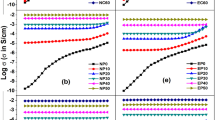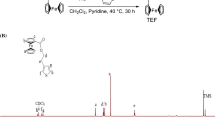Abstract
Like electrical conductivity, the electromagnetic interference shielding effectiveness (EMI SE) of carbon-containing polymeric composites also goes through a transition phase known as the percolation threshold (PT). In this study, the applicability of various sigmoidal models such as sigmoidal–Boltzmann (SB), sigmoidal–dose response (SD), sigmoidal–Hill (SH), sigmoidal–logistic (SL), and sigmoidal–logistic-1 (SL-1) to determine the PT of EMI SE has been tested for composites of ethylene vinyl acetate (EVA) copolymer and acrylonitrile butadiene rubber (NBR) matrix reinforced with various particulate and fibrous carbon fillers. It is observed that the SB and SD models predicted similar PT. On the other hand, other models reported different values when validated for any particular composite system. The difference in results of PT has been discussed in detail from a viewpoint of the benefits and vice versa of these models. Also, the classical percolation theory has been applied to determine the PT of EMI SE for comparison with the values obtained through the sigmoidal models. In order to judge the universal acceptability of these models, the EMI SE results have been tested for various polymeric composites taken from some published literature. The results indicate that all the models except the SL-1 model can be successfully applied for predicting the PT of EMI SE for polymer composites.
Graphical Abstract









Similar content being viewed by others
References
R.J. Chandra, B. Shivamurthy, S.D. Kulkarni, and M.S. Kumar, Mater. Res. Express 6, 082008 (2019).
T. Williams, in EMC Prod. Des. (Newnes, 1992), pp. 171–210.
M.-S. Cao, W.-L. Song, Z.-L. Hou, B. Wen, and J. Yuan, Carbon 48, 788 (2010).
X. Luo, and D.D.L. Chung, Compos. Part B Eng. 30, 227 (1999).
K. Balasubramanian, M. Tirumali, Y. Badhe, and Y. R. Mahajan, in Aerosp. Mater. Mater. Technol. (Springer, 2017), pp. 439–453.
Z. Fan, D. Wang, Y. Yuan, Y. Wang, Z. Cheng, Y. Liu, and Z. Xie, Chem. Eng. J. 381, 122696 (2020).
V.T. Rathod, J.S. Kumar, and A. Jain, Appl. Nanosci. 7, 519 (2017).
P. Los, A. Lukomska, and R. Jeziorska, Polimery 61, (2016).
B. Moazzenchi, and M. Montazer, Colloids Surf. Physicochem. Eng. Asp. 571, 110 (2019).
K. Raagulan, J.S. Ghim, R. Braveenth, M.J. Jung, S.B. Lee, K.Y. Chai, B. Mi Kim, and J. Lee, Nanomaterials 10, 2086 (2020).
L.-C. Jia, D.-X. Yan, Y. Yang, D. Zhou, C.-H. Cui, E. Bianco, J. Lou, R. Vajtai, B. Li, and P.M. Ajayan, Adv. Mater. Technol. 2, 1700078 (2017).
Y. Xu, Y. Yang, D.-X. Yan, H. Duan, G. Zhao, and Y. Liu, Chem. Eng. J. 360, 1427 (2019).
J. Han, J. Lee, J. Lee, and J. Yeo, Adv. Mater. 30, 1704626 (2018).
R. Kumar, A. Sharma, A. Pandey, A. Chaudhary, N. Dwivedi, D.P. Mondal, and A.K. Srivastava, Sci. Rep. 10, 1 (2020).
A. Sharma, R. Kumar, V.K. Patle, R. Dhawan, A. Abhash, N. Dwivedi, D.P. Mondal, and A.K. Srivastava, Compos. Commun. 22, 100433 (2020).
J. Varghese, N. Joseph, H. Jantunen, S. K. Behera, H. T. Kim, M. T. Sebastian, Handb. Adv. Ceram. Compos. Def. Secur. Aerosp. Energy Appl. 165 (2020).
Z. Liu, G. Bai, Y. Huang, F. Li, Y. Ma, T. Guo, X. He, X. Lin, H. Gao, and Y. Chen, J. Phys. Chem. C 111, 13696 (2007).
D.D.L. Chung, Carbon 39, 279 (2001).
S. Sankaran, K. Deshmukh, M.B. Ahamed, and S.K. Pasha, Compos. Part Appl. Sci. Manuf. 114, 49 (2018).
A. J. Epstein, in Conduct. Polym. Plast. (Elsevier, 1999), pp. 1–9.
M.H. Al-Saleh, and U. Sundararaj, Carbon 47, 1738 (2009).
J. Liang, Y. Wang, Y. Huang, Y. Ma, Z. Liu, J. Cai, C. Zhang, H. Gao, and Y. Chen, Carbon 47, 922 (2009).
N. Li, Y. Huang, F. Du, X. He, X. Lin, H. Gao, Y. Ma, F. Li, Y. Chen, and P.C. Eklund, Nano Lett. 6, 1141 (2006).
Y. Yang, M.C. Gupta, K.L. Dudley, and R.W. Lawrence, J. Nanosci. Nanotechnol. 5, 927 (2005).
R. Jan, A. Habib, M.A. Akram, I. Ahmad, A. Shah, M. Sadiq, and A. Hussain, Mater. Res. Express 4, 035605 (2017).
S.H. Lee, S. Yu, F. Shahzad, W.N. Kim, C. Park, S.M. Hong, and C.M. Koo, Nanoscale 9, 13432 (2017).
S.S. Pradhan, L. Unnikrishnan, S. Mohanty, and S.K. Nayak, J. Electron. Mater. 49, 1749 (2020).
M. Mishra, A.P. Singh, V. Gupta, A. Chandra, and S.K. Dhawan, J. Alloys Compd. 688, 399 (2016).
D. Wanasinghe, F. Aslani, G. Ma, and D. Habibi, Nanomaterials 10, 541 (2020).
M. Rahaman, A. Aldalbahi, P. Govindasami, N. Khanam, S. Bhandari, P. Feng, and T. Altalhi, Polymers 9, 527 (2017).
M. Rahaman, T.K. Chaki, and D. Khastgir, Adv. Sci. Lett. 10, 115 (2012).
A.L. Navarro-Verdugo, F.M. Goycoolea, G. Romero-Meléndez, I. Higuera-Ciapara, and W. Argüelles-Monal, Soft Matter 7, 5847 (2011).
J. Reséndiz-Muñoz, M.A. Corona-Rivera, J.L. Fernández-Muñoz, M. Zapata-Torres, A. Márquez-Herrera, and V.M. Ovando-Medina, Bull. Mater. Sci. 40, 1043 (2017).
E.A. Hernández-Caraballo, O. Rodríguez-Rodríguez, and V. Rodríguez-Pérez, Environ. Exp. Bot. 64, 225 (2008).
M. Rahaman, T.K. Chaki, and D. Khastgir, Polym. Compos. 32, 1790 (2011).
N.J.S. Sohi, S. Bhadra, and D. Khastgir, Carbon 49, 1349 (2011).
M. Rahaman, T.K. Chaki, and D. Khastgir, J. Mater. Sci. 46, 3989 (2011).
L. Haanstra, P. Doelman, and J.O. Voshaar, Plant Soil 84, 293 (1985).
A. DeLean, P.J. Munson, and D. Rodbard, Am. J. Physiol.-Endocrinol. Metab. 235, E97 (1978).
C. Ritz and J. Strebig, J. Stat. Softw. 12, (2005).
M.B. Hinojosa, J.A. Carreira, J.M. Rodríguez-Maroto, and R. García-Ruíz, Sci. Total Environ. 396, 89 (2008).
R.L. Buchanan, J.L. Smith, and W. Long, Int. J. Food Microbiol. 58, 159 (2000).
N. Bairagi, and D. Adak, Chaos Solitons Fractals 103, 52 (2017).
S. Blatt, D.A. Joseph, G.C. Cutler, A.R. Olson, and S. White, Can. Entomol. 152, 374 (2020).
B. Anandaraj, S. Eswaramoorthi, T.P. Rajesh, J. Aravind, and P.S. Babu, Int. J. Environ. Sci. Technol. 15, 2595 (2018).
A.W. El-Kareh, and T.W. Secomb, Neoplasia 7, 705 (2005).
S. M. Swinton and C. P. Lyford, J. Agric. Biol. Environ. Stat. 97 (1996).
E.A. Christou, M. Grossman, and L.G. Carlton, J. Mot. Behav. 34, 67 (2002).
S.K. Pankaj, N.N. Misra, and P.J. Cullen, Innov. Food Sci. Emerg. Technol. 19, 153 (2013).
J. Weiner, S. Kinsman, and S. Williams, Am. J. Bot. 85, 1638 (1998).
S. Kawakita, N. Ishikawa, H. Takahashi, R. Okuno, and T. Takahashi, J. Agric. Meteorol. 76, 81 (2020).
M.A. Martín, R. Fernández, M.C. Gutiérrez, and J.A. Siles, Process Saf. Environ. Prot. 117, 245 (2018).
H. Bazyar, L. Xu, H. J. de Vries, S. Porada, and R. Lammertink, Environ. Sci. Water Res. Technol. (2020).
A. Ware, and N. Power, Renew. Energy 104, 50 (2017).
S. Yahuza, B.I. Dan-Iya, and I.A. Sabo, J. Biochem. Microbiol. Biotechnol. 8, 42 (2020).
A. Farazmand and M. Amir-Maafi, Persian J. Acarol. 7, (2018).
M. Abdulrasheed, I.I. Hussein, I. Ahmad, M.M. Namadina, F. Muhammad, and S. Ibrahim, Bioremed. Sci. Technol. Res. 8, 27 (2020).
V.K. Shante, and S. Kirkpatrick, Adv. Phys. 20, 325 (1971).
S.M. Mishra, and B.D. Rohera, Pharm. Dev. Technol. 24, 954 (2019).
N. Jarvis, M. Larsbo, and J. Koestel, Geoderma 287, 71 (2017).
B. Tavagh-Mohammadi, M. Masihi, and M. Ganjeh-Ghazvini, Phys. Stat. Mech. Its Appl. 460, 304 (2016).
D. Amaro, J. Bennett, D. Vodola, and M. Müller, Phys. Rev. A 101, 032317 (2020).
M. Rahaman, I. A. Al Ghufais, G. Periyasami, and A. Aldalbahi, Int. J. Polym. Sci. 2020, (2020).
N. Joseph, and M.T. Sebastian, Mater. Lett. 90, 64 (2013).
R. Ravindren, S. Mondal, P. Bhawal, S.M.N. Ali, and N.C. Das, Polym. Compos. 40, 1404 (2019).
S. Mondal, S. Ganguly, M. Rahaman, A. Aldalbahi, T.K. Chaki, D. Khastgir, and N.C. Das, Phys. Chem. Chem. Phys. 18, 24591 (2016).
Acknowledgments
We acknowledge King Saud University, Riyadh, Saudi Arabia, for funding this work through Researchers Supporting Project Number (RSP-2021/30).
Funding
This study was funded by Researchers Supporting Project Number from King Saud University, Riyadh, Saudi Arabia (RSP-2021/30).
Author information
Authors and Affiliations
Corresponding authors
Ethics declarations
Conflict of interest
The authors declare that they have no conflict of interest.
Additional information
Publisher's Note
Springer Nature remains neutral with regard to jurisdictional claims in published maps and institutional affiliations.
Supplementary Information
Below is the link to the electronic supplementary material.
Rights and permissions
About this article
Cite this article
Rahaman, M., Gupta, P., Hossain, M. et al. Predicting Percolation Threshold Value of EMI SE for Conducting Polymer Composite Systems Through Different Sigmoidal Models. J. Electron. Mater. 51, 1788–1803 (2022). https://doi.org/10.1007/s11664-022-09444-7
Received:
Accepted:
Published:
Issue Date:
DOI: https://doi.org/10.1007/s11664-022-09444-7




